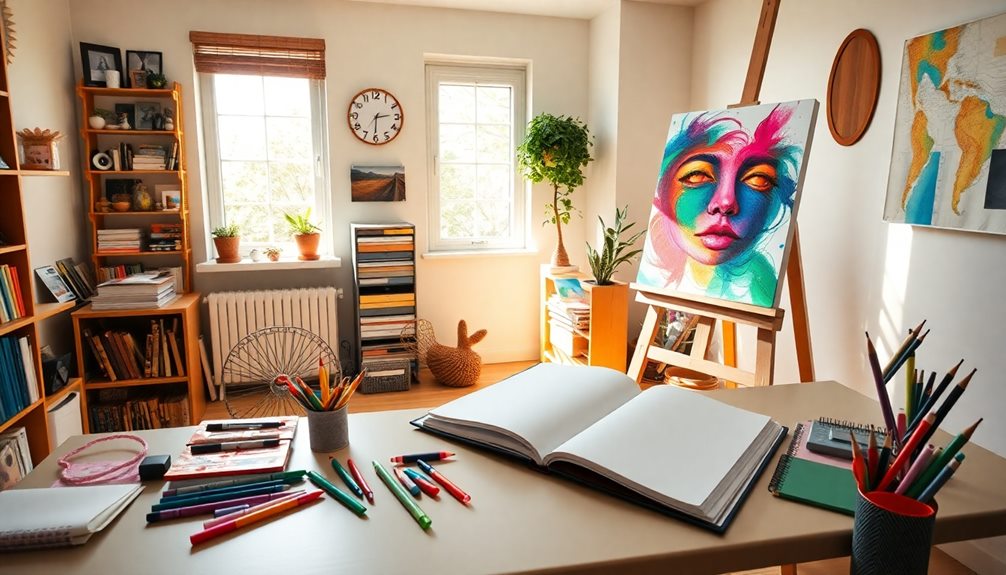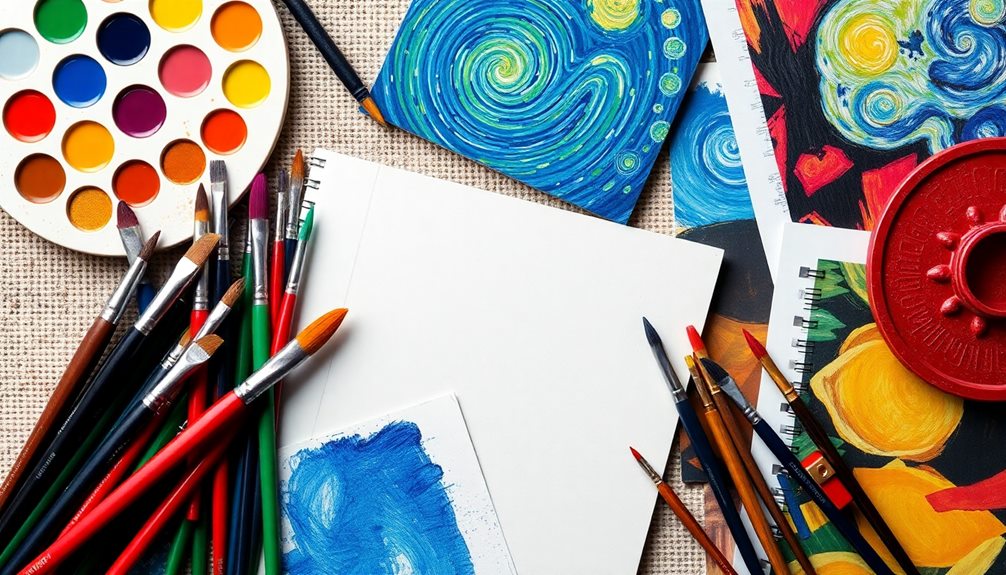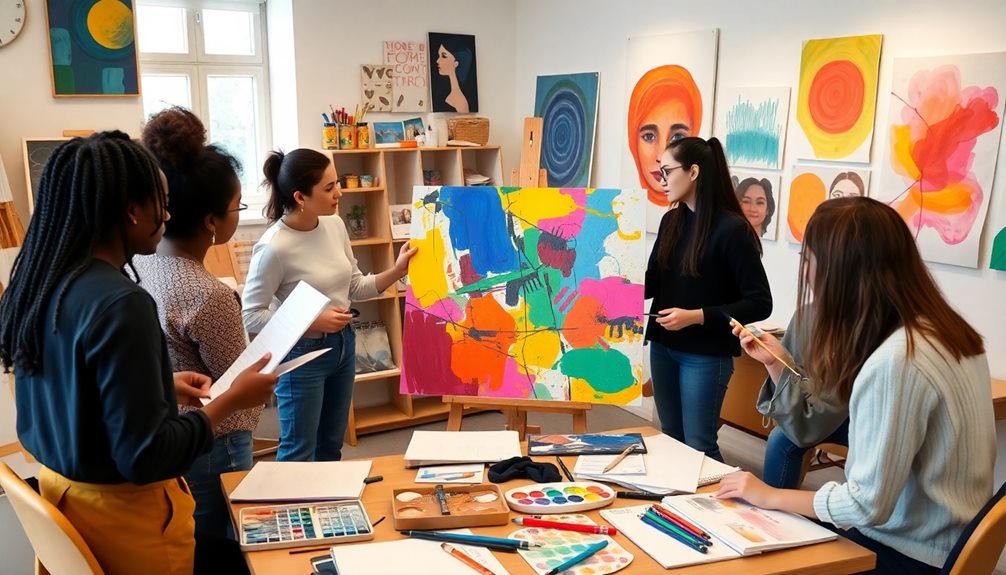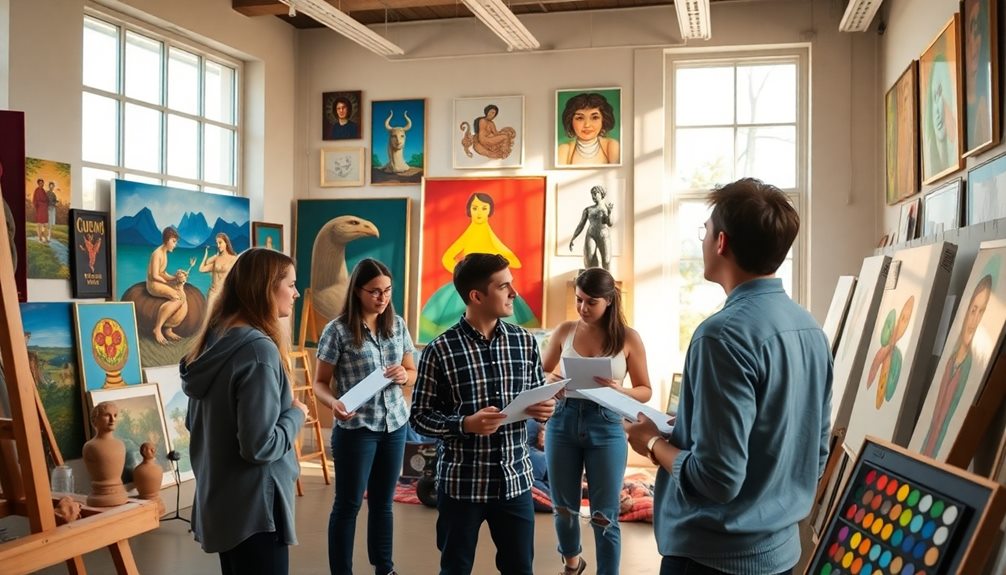If you're diving into art analysis, start by understanding its core concepts. Focus on formal analysis, examining elements like line and color. Use the four-step process: LOOK, DESCRIBE, THINK, CONNECT. This helps you interpret not just what you see but also the artist's intent. Context matters, so explore socio-political backgrounds. Look for deeper meanings beyond the surface. Support your observations with clear evidence and relevant terminology. Engaging with artwork can be an exciting journey, revealing complexities and narratives that enrich your experience. There's so much more to uncover about analyzing art effectively.
Key Takeaways
- Art analysis enhances understanding by exploring the artist's decisions, techniques, and the broader context of the artwork.
- Use the structured four-step process: LOOK, DESCRIBE, THINK, CONNECT for effective analysis.
- Formal analysis emphasizes visual evidence, examining elements like line, shape, color, and texture.
- Contextual analysis provides deeper insights by exploring the socio-political background influencing the artwork.
- Engage actively through observation, guided questions, and collaborative discussions to foster a richer appreciation of art.
Introduction

Art analysis is crucial for anyone looking to deepen their understanding of visual works. It goes beyond simple observation and invites you to explore the decisions made by the artist. By engaging in formal analysis, you'll gain insight into compositional devices and personal artistic techniques that shape the artwork. This structured approach emphasizes the importance of visual evidence, allowing students learning to connect their observations to the elements within the piece.
Moreover, much like the impact of automation, art analysis enhances your ability to interpret and engage with complex narratives, fostering a deeper appreciation for artistic expression.
When you view art as a series of choices, it encourages a more profound interpretation of the work. This perspective shifts your focus from mere personal impressions to a critical examination of the context surrounding the artwork. Understanding factors like the artist's background, historical period, and cultural influences will enhance your analysis and appreciation.
Engaging with art through visual analysis not only deepens your connection to specific pieces but also fosters a sense of belonging within the artistic community. By developing these analytical skills, you contribute to a richer dialogue about art and its significance in society.
Key Concepts and Definitions

Understanding the key concepts and definitions in art analysis lays the groundwork for your exploration of visual works. Formal analysis is essential; it focuses on the visual evidence in a piece rather than personal feelings.
As you dive into analysis, you'll examine various formal elements—like line, shape, color, texture, and composition. These elements help you describe the work in a structured way. Additionally, just as candle making requires careful attention to materials and processes, so does art analysis demand focus on the foundational aspects of each piece, including the medium and technique used. By understanding these elements, you can draw parallels to how elements like wax types influence the final outcome in candle making.
The process typically involves four steps: LOOK (observe), DESCRIBE (detail visual characteristics), THINK (interpret meaning), and CONNECT (relate to broader contexts). By following this structure, you can develop a clearer understanding of the artwork.
As students look closely at the formal elements, they'll uncover deeper insights and connections that reveal thematic and contextual implications.
It's crucial to maintain clarity and objectivity in your written analysis. Using specific terminology allows you to convey complex visual observations effectively. Emphasizing principles of design, such as balance, unity, and emphasis, can enhance your critique.
Ultimately, mastering these key concepts and definitions will empower you to engage more thoughtfully with art and articulate your insights with confidence.
Art Interpretation Techniques

Exploring various interpretation techniques can significantly enhance your engagement with visual artworks. Start by looking closely at the elements and principles of the piece—notice the lines, shapes, colors, and textures. These formal aspects often hold the key to understanding the artist's intent and the artwork's overall message.
Additionally, considering the socio-political context of the artwork can provide further insights, as seen in urban landscapes which often reflect the rapid modernization of Indian cities and engage with contemporary issues urban themes reflect modernization.
To deepen your analysis, consider employing structured frameworks like the LOOK, DESCRIBE, THINK, and CONNECT process. This method promotes a systematic approach to engage with the artwork, encouraging personal connections and reflections.
Contextual analysis is another vital technique. By examining the artist's background, historical period, and cultural influences, you can uncover layers of meaning that mightn't be immediately apparent.
Don't hesitate to use guided questions during discussions, as they stimulate critical thinking and broaden your exploration of the artwork's significance.
Lastly, comparative analysis between different artworks can reveal recurring themes and stylistic elements, enriching your appreciation of the art form. By combining these art interpretation techniques, you'll cultivate a deeper understanding and connection to the visual world around you.
Real-World Art Analysis Examples

Numerous real-world examples demonstrate how art serves as a powerful medium for conveying cultural narratives and contemporary issues.
Take the Egyptian Coffin of Pedi-Osiris, for instance. This work of art, dating back to 305 BC, showcases intricate carvings and gold embellishments, highlighting the significance of funerary art in ancient Egyptian culture.
Similarly, Subodh Gupta's Untitled (2008) uses stainless steel to comment on globalization and identity, blending traditional and modern materials.
In John Biggers' Jubilee: Ghana Harvest Festival (1959-63), vibrant colors and dynamic compositions celebrate African heritage, providing students to use elements of color theory in their analyses.
The Akan Linguist Staff (1885-95) made of wood and gold leaf symbolizes power and eloquence, serving as a vital communication tool in traditional ceremonies.
Lastly, Georgia O'Keeffe's Red Hill and White Shell (1938) exemplifies abstraction through bold colors and simplified forms, reflecting her deep connection to New Mexico's landscapes.
These varied works of art demonstrate the diverse ways artists convey messages, allowing students to use their analytical skills to explore deeper meanings and cultural contexts.
Tips and Best Practices

Art analysis requires a keen eye and a thoughtful approach to truly appreciate the depth of a piece. To excel in your analysis of the work, devote time to carefully observe the visual elements like line, shape, color, and texture. This foundational observation will enhance your understanding of the artwork's nuances.
Utilize structured frameworks, such as the Four-Step Process: LOOK, DESCRIBE, THINK, and CONNECT, to guide your analysis. This method encourages you to engage deeply with the piece and make connections between its elements and broader themes.
Incorporate relevant terminology and art concepts in your writing; doing so will clarify your arguments and strengthen your insights about the artwork's impact. Support your opinions with evidence derived from formal elements, ensuring your analysis goes beyond mere description to convey meaningful interpretations.
Audience Engagement With Art

Engaging viewers with art goes beyond mere observation; it's about fostering an emotional connection that invites deeper reflection. To enhance audience engagement, you should encourage students to explore not just the works of art but also the emotions and thoughts they evoke.
Use guided questions during discussions to stimulate critical thinking and prompt viewers to share their interpretations and responses. This approach not only enriches understanding but also opens up new avenues for appreciation.
Collaborative discussions and peer feedback create a dynamic environment where diverse perspectives shine, enhancing the overall experience. Incorporating multimedia resources like videos and interactive content can further deepen engagement, making artistic concepts more relatable and accessible.
Encouraging students to sketch or annotate elements of the work allows them to actively participate in the analysis process. This hands-on approach creates a more profound and personal connection to the art, inviting them to express their thoughts visually and textually.
Cultural Context Impacts Interpretation

Understanding cultural context enriches your interpretation of artworks and reveals the layers of meaning behind them. Cultural context plays a critical role in shaping how you perceive art, as it reflects the historical, social, and political influences present at the time of creation.
When you consider an artist's background, including their cultural identity and personal experiences, you can better appreciate the themes and choices they explore in their work. Artworks often serve as commentaries on societal norms or issues, so grasping the cultural environment is essential for analyzing their significance.
The intended audience and the artwork's original purpose—whether for religious, political, or personal expression—greatly influence how it's perceived and understood. As you dive into art history, recognize how connections between an artwork and contemporary cultural movements enhance your appreciation.
This awareness reveals deeper meanings related to identity, tradition, and change. By examining the cultural context, you'll unlock a richer interpretation of the artwork, uncovering insights that might otherwise remain hidden. Embrace this approach, and you'll find that art becomes not just an object, but a vibrant dialogue with its time and place.
Additional Resources

Exploring cultural context deepens your appreciation of art, but it's just the beginning. To enhance your understanding further, tap into a wealth of additional resources.
Online platforms like Khan Academy and Google Arts & Culture offer comprehensive art history lessons and visual analysis tools that can help you grasp complex concepts. For a thought-provoking read, check out "Ways of Seeing" by John Berger, which dives into how context shapes our perception of art.
If you're serious about writing about art, consider accessing scholarly journals like "The Art Bulletin" and "Art Journal." These publications provide in-depth research articles that explore various art movements and methodologies, perfect for high school art projects or essays.
Don't forget to engage in local art workshops or gallery talks. These events allow you to interact directly with artists and curators, providing firsthand perspectives on contemporary art practices.
Finally, educational platforms like Coursera and edX offer courses taught by university professors and industry experts, making them invaluable for anyone looking to deepen their knowledge in art history: A Preliminary study.
Use these resources to expand your artistic insights!
Frequently Asked Questions
How Do You Analyze Art for Beginners?
To analyze art as a beginner, start by observing details like colors and shapes. Then, describe what you see, interpret its meaning, and connect it to broader themes or personal experiences for deeper understanding.
What Are the 4 Steps of Art Analysis?
To analyze art, you follow four steps: LOOK closely at the artwork, DESCRIBE its elements, THINK about the emotions and messages it conveys, and CONNECT it to other works or experiences for deeper understanding.
What Are the 3 Main Parts of an Art Analysis?
In art analysis, you focus on three main parts: Description, where you detail visual elements; Interpretation, where you uncover meaning; and Judgment, where you evaluate the artwork's effectiveness and your emotional response to it.
How Do You Structure an Art Analysis?
To structure your art analysis, start with a clear thesis, then break it into sections covering formal elements like color and texture. Conclude by connecting your findings to broader artistic themes and movements for deeper insights.
Conclusion
In conclusion, diving into art analysis opens up a world of understanding and appreciation. By grasping key concepts, employing interpretation techniques, and considering cultural contexts, you'll enhance your ability to engage with art on a deeper level. Remember to stay curious and explore various perspectives. The more you analyze, the richer your experience becomes. So, grab a piece of art, apply what you've learned, and enjoy the journey of discovery that awaits you!









